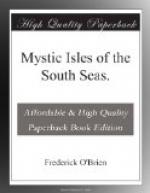I start for Tautira—A dangerous adventure in a canoe—I go by land to Tautira—I meet Choti and the Greek God—I take up my home where Stevenson lived.
Seeing the way the Lermontoffs lived, caused me to resolve that during the remainder of my stay in Tahiti I would go even farther from Papeete than Mataiea. They suggested Tautira, a village they had never visited, but which was at the very end of the habitable part of the Presqu’ile of Taiarapu. My easiest route to Tautira was by crossing the isthmus of Taravao, to the other side of the peninsula, as nowhere in Tahiti except at Lake Vaihiria were there even passable trails across the lofty spine of the island. I was for sending back the cart and horse to Taravao and taking a canoe to Tautira. A council of the elders of Vaieri opposed me, but yielded to my persistence by advising me at least to ride as far as possible in the cart along the western road, and to find, nearer to Tautira, in Maora, or farther on, in Puforatoai, a canoe and canoeists for the risky attempt.
Tatini, who had lagged behind at Butscher’s, appeared as I harnessed the horse. She had accompanied the Tinito storekeeper of Taravao to Vaieri, and would not permit me to go on alone. She climbed into the vehicle, and we wended a winding road, and forded several streams until we came to Puforatoai, having gone through Hatiti and Maora. There was a pass in the reef admitting to a questionable shelter, Port Beaumanoir, used by the French when little gunboats threatened to bombard villages to force the rule of Paris.
Puforatoai was a handful of houses, hardly a village. My advent was of importance, and its few people gathered about us. They voiced their amazement when Tatini announced our wish to find a navigator and vessel to Tautira. They all said it was impossible, that the coast to Pari, with the submerged reef of Faratara, was too rough now for any but a large power boat, and the wind would be baffling and threatening. But as fear of the sea was unknown to them, they expressed a will to make the attempt. We launched a large canoe, and two sturdy natives, relations of Tatini, took the paddles. They had made the journey more than once, but not at this season.
We got into difficulties from the start. The shores were very different from those of Mataiea, Papeari, and Vairao, the three districts I had come through from the house of Tetuanui. The alluvial strip of land which in them stretched from a quarter of a mile to a mile from the lagoon to the slopes of the hills, here was cramped to the barest strip. The huts of the indigenes, few and far apart outside of Puforatoai, seemed to be set in terraces cut at the foot of the mountains which rose almost straight from the streak of golden sand to the skies. In every shade of green, as run by the overhead sun upon the altering facets of precipice and shelf, of fei and cocoa, candlenut and purau, giant ferns and convolvulus, tier upon tier, was a riot of richest vegetation. But everywhere in the lagoon were bristling and hiding dangers from hummocks of coral and sunken banks.




